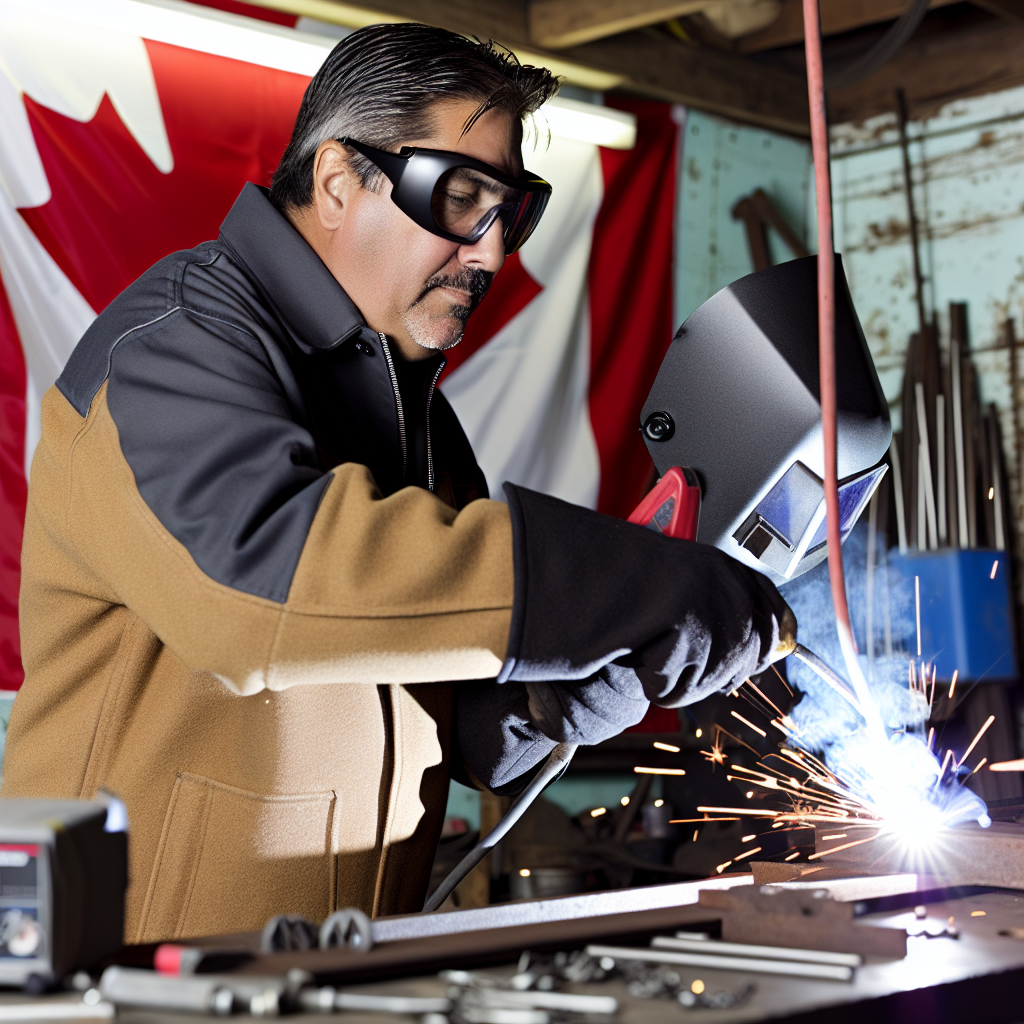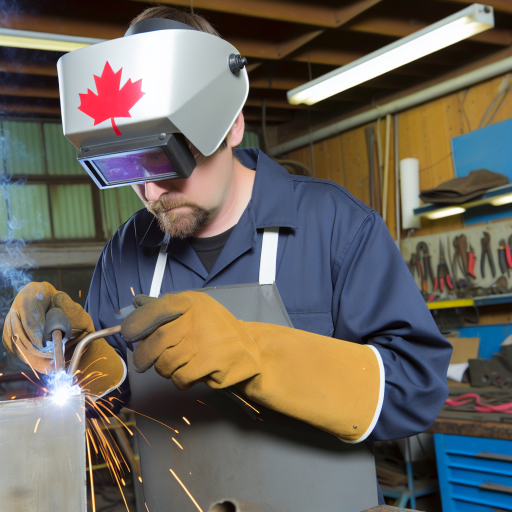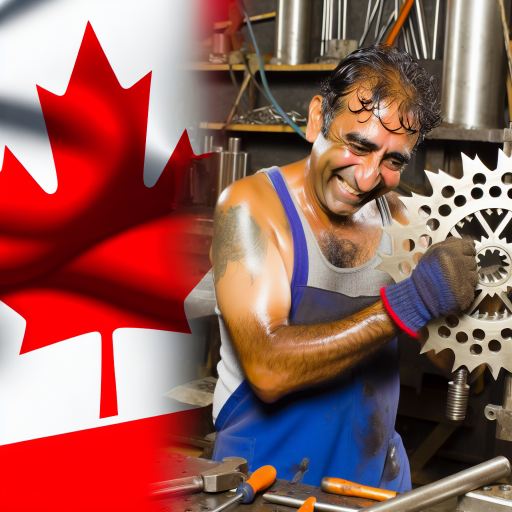Introduction to Metal Fabrication
Definition of Metal Fabrication
Metal fabrication involves creating structures from raw materials.
It includes processes such as cutting, bending, and assembling metal.
This field serves numerous industries, including construction, manufacturing, and automotive.
Importance of Metal Fabrication in Canada
Metal fabrication plays a critical role in Canada’s economy.
It supports various sectors by providing essential components.
Canadian manufacturers rely on metal fabricators for quality products.
Furthermore, this industry fosters job creation across the nation.
Key Contributions of Metal Fabricators
Metal fabricators enhance infrastructure development significantly.
They supply crucial metal components for buildings and bridges.
Moreover, fabricators provide solutions that improve overall safety.
Their work contributes to energy efficiency and sustainability initiatives.
Challenges Faced by the Metal Fabrication Industry
The industry faces challenges like rising material costs.
Additionally, skilled labor shortages impact production quality.
Technological advancements require constant adaptation from fabricators.
Despite these challenges, growth opportunities remain abundant.
Historical Overview of Metal Fabrication in Canada
Origins of Metal Fabrication
The history of metal fabrication in Canada dates back to the early 19th century.
Initially, the industry focused on essentials like tools and agricultural equipment.
Craftsmen worked with simple hand tools to create these basic items.
As demand grew, so did the complexity of fabrication techniques.
The Industrial Revolution
The Industrial Revolution significantly influenced Canadian metal fabrication.
New machines and technologies emerged during the late 1800s.
Manufacturers adopted steam power to increase production efficiency.
This period also saw the establishment of Canada’s first steel mills.
Consequently, the industry experienced rapid growth and expansion.
The 20th Century Era
The 20th century brought advancements in metal fabrication technologies.
Unlock Your Career Potential
Visualize a clear path to success with our tailored Career Consulting service. Personalized insights in just 1-3 days.
Get StartedWelding, machining, and cutting techniques evolved during this time.
This evolution allowed for more complex designs and larger structures.
Moreover, World War II created a surge in demand for metal goods.
Canadian manufacturers played a crucial role in supporting the war effort.
Modern Developments
The late 20th century introduced automation and computerization.
These innovations transformed the metal fabrication landscape in Canada.
Robotics and CNC (Computer Numerical Control) machines became prevalent.
Such technologies enhanced precision and reduced manufacturing costs.
Current State of the Industry
Today, Canada boasts a diverse and competitive metal fabrication industry.
The sector serves various markets, including construction and transportation.
Innovative practices focus on sustainability and resource efficiency.
Canadian fabricators increasingly prioritize eco-friendly processes.
As a result, they aim to minimize waste and environmental impact.
Key Industries Employing Metal Fabricators in Canada
Construction Industry
The construction industry heavily relies on metal fabricators.
They create structural components like beams and columns.
These elements ensure the safety and stability of buildings.
Additionally, fabricators produce sheet metal for roofing and siding.
This industry continually seeks skilled metalworkers for various projects.
Manufacturing Sector
The manufacturing sector is another major employer of metal fabricators.
Here, fabricators create parts for machinery and equipment.
They also produce products for consumer goods and automotive industries.
Furthermore, precision is crucial in this sector.
This demand drives innovation and skill development among fabricators.
Aerospace and Defense
Aerospace and defense sectors require specialized fabricators.
They manufacture components for aircraft and military equipment.
Additionally, these sectors demand high-quality standards.
Certain projects focus on lightweight yet strong materials.
Thus, skilled fabricators play a critical role in meeting these needs.
Energy Sector
The energy sector significantly employs metal fabricators.
Fabricators create components for renewable energy solutions.
Solar panels and wind turbines depend on their expertise.
Additionally, fabricators work on traditional energy infrastructures.
They ensure the durability and efficiency of energy-related projects.
Transportation Industry
Metal fabricators contribute to the transportation industry as well.
They produce parts for vehicles, trains, and ships.
Quality assurance is crucial for safety in transport applications.
Furthermore, fabricators adapt to new technologies.
As a result, they help improve transportation efficiency and performance.
You Might Also Like: Best Practices for Precision in Metal Fabrication Work
Skills and Qualifications Required for Metal Fabricators
Education and Training
Metal fabricators need a solid educational background.
Many start with a high school diploma or equivalent.
Relevant courses in mathematics and physics are beneficial.
Some employers prefer candidates with vocational training.
Community colleges offer programs specifically in metal fabrication.
Apprenticeships provide hands-on experience in the field.
Trade certification is an asset for career advancement.
Technical Skills
Proficiency in reading blueprints is essential for fabricators.
Fabricators must understand welding techniques and processes.
Knowledge of various metals and their properties is important.
Familiarity with cutting and shaping tools is a must.
Additionally, experience with computer-aided design software is valuable.
Soft Skills
Strong problem-solving skills help fabricators overcome challenges.
Attention to detail ensures precision in work.
Effective communication skills are necessary for teamwork.
Time management skills help meet project deadlines consistently.
Physical stamina is an asset in this demanding field.
Discover More: Tips for Maintaining HVAC Systems Like a Pro
The Role of Technology in Metal Fabrication
Automation in Metal Fabrication
Automation significantly transforms metal fabrication processes.
It enhances productivity and reduces human error.
Moreover, automation minimizes production time.
Today’s metal fabricators employ advanced machinery for precision tasks.
This technology allows for consistent quality across projects.
For instance, CNC machines automate cutting and shaping of metals.
In addition, robotic systems streamline welding processes.
As a result, companies increase throughput and reduce costs.
Automation also enables fabricators to handle complex designs efficiently.
Innovation in Materials
Innovation leads to the development of new metal alloys.
These alloys often combine lightweight features with strength.
For example, aluminum-lithium alloys are gaining popularity.
Such materials are ideal for aerospace and automotive industries.
Furthermore, 3D printing technology facilitates rapid prototyping.
This method allows for intricate shapes and designs previously unattainable.
Fabricators can quickly iterate on designs, speeding up production.
Consequently, companies can respond promptly to market demands.
Software Advancements
Software plays a crucial role in modern metal fabrication.
Design software aids in creating detailed models before production.
Additionally, simulation software predicts material behavior under stress.
This capability helps in optimizing designs for durability and performance.
Moreover, inventory management software streamlines supply chain activities.
Fabricators can track their resources and reduce waste effectively.
As a result, overall operational efficiency improves significantly.
The Future of Metal Fabrication Technology
The future of metal fabrication looks promising with ongoing technological advancements.
Artificial intelligence will likely play a key role in decision-making processes.
Machine learning algorithms can analyze production data for optimization.
Additionally, developments in sustainable practices are on the rise.
Fabricators are adopting eco-friendly materials and processes.
This shift not only benefits the environment but also enhances brand reputation.
Ultimately, these technological trends will shape the industry’s future landscape.
Delve into the Subject: Understanding the Daily Tasks of an HVAC Technician

Work Environment and Safety Standards for Metal Fabricators in Canada
Overview of the Work Environment
Metal fabricators in Canada typically work in industrial settings.
These environments include factories, workshops, and construction sites.
They use various tools and machinery to manipulate metals.
Common tasks involve cutting, bending, and assembling metal parts.
Workers often collaborate in teams to complete projects efficiently.
Safety Standards in the Metal Fabrication Industry
Safety is a top priority in the metal fabrication industry.
Canadian regulations mandate strict adherence to safety protocols.
Workplaces must implement safety management systems to protect employees.
Employers must ensure proper training for all staff members.
Regular safety audits help maintain high standards.
PPE and Its Importance
Personal protective equipment (PPE) is essential for metal fabricators.
Workers must wear welding helmets to protect against sparks and debris.
Heavy-duty gloves prevent cuts and abrasions during handling.
Steel-toed boots ensure foot safety in hazardous environments.
High-visibility vests improve worker visibility on the job site.
Common Hazards and Risk Management
Metal fabrication involves various hazards that workers must recognize.
These include mechanical, chemical, and thermal risks.
Proper training helps workers identify and mitigate these risks.
Employers should foster a culture of safety within the workplace.
Regular hazard assessments support ongoing safety improvements.
The Role of Training and Education
Training programs are vital for maintaining safety standards.
These programs equip workers with essential skills and knowledge.
Certification courses focus on specific equipment and safety protocols.
Mentoring programs enhance practical experience through hands-on training.
Continual education ensures workers stay updated with safety standards.
You Might Also Like: What It’s Really Like to Be an Electrician in Canada: Day in the Life
Challenges Facing Metal Fabricators in Canada
Labor Shortages
Metal fabricators in Canada face significant labor shortages.
This issue affects small and large companies alike.
The demand for skilled labor continues to rise.
Unfortunately, the supply of trained workers is inadequate.
Many fabricators struggle to find qualified welders and machinists.
This gap creates delays in production and project completion.
Moreover, companies often offer higher wages to attract talent.
However, this can strain operational budgets.
Apprenticeship programs are one way to tackle this issue.
Encouraging young people to join the industry is essential.
Economic Factors
The economic landscape also presents challenges for metal fabricators.
Recent fluctuations in material costs severely impact profitability.
For example, rising steel prices create budget constraints.
Additionally, the global supply chain disruptions lead to delays.
Many fabricators find it hard to secure necessary materials.
Economic uncertainty makes planning for the future difficult.
Investments in new technology become riskier as a result.
Furthermore, competition increases both locally and internationally.
Staying competitive requires continuous innovation and adaptation.
Consequently, fabricators must navigate these economic hurdles wisely.
Future Trends in Metal Fabrication: Sustainability and Green Practices
Shift Towards Sustainable Materials
Sustainable materials are gaining popularity in metal fabrication.
Recycled metals reduce environmental impact significantly.
More companies, like EcoMetal Works, emphasize using high-quality recycled materials.
Changing regulations also drive the shift towards sustainability.
Energy Efficiency in Production
Energy efficiency remains a top priority in metal fabrication.
Manufacturers are adopting technologies that minimize energy consumption.
For instance, advanced machinery and automation systems enhance efficiency.
Additionally, companies like GreenTech Metals implement strict energy audits.
Reduction of Waste and Byproducts
Cutting-edge technologies help minimize waste generation.
Companies are investing in systems that recycle scrap metal effectively.
Moreover, lean manufacturing principles reduce overall waste output.
For example, MetalCraft Innovations has implemented innovative reclamation processes.
Regulatory Compliance and Consumer Demand
Regulatory changes push industries towards greener practices.
Companies must comply with stricter environmental regulations.
Consequently, consumer demand for sustainable products is rising.
Brands like EcoFusion Fabricators respond by prioritizing eco-friendly options.
Adoption of Eco-Friendly Technologies
New technologies in fabrication are environmentally conscious.
3D printing and other digital tools reduce waste significantly.
Furthermore, the adoption of renewable energy sources is increasing.
For example, SolarTech Fabrications integrates solar power into operations.
Collaboration and Community Initiatives
Collaboration between industries fosters sustainable practices.
Companies partner with environmental organizations for joint initiatives.
For instance, SteelNation collaborates with local communities for recycling programs.
Furthermore, educational campaigns raise awareness about sustainability.




